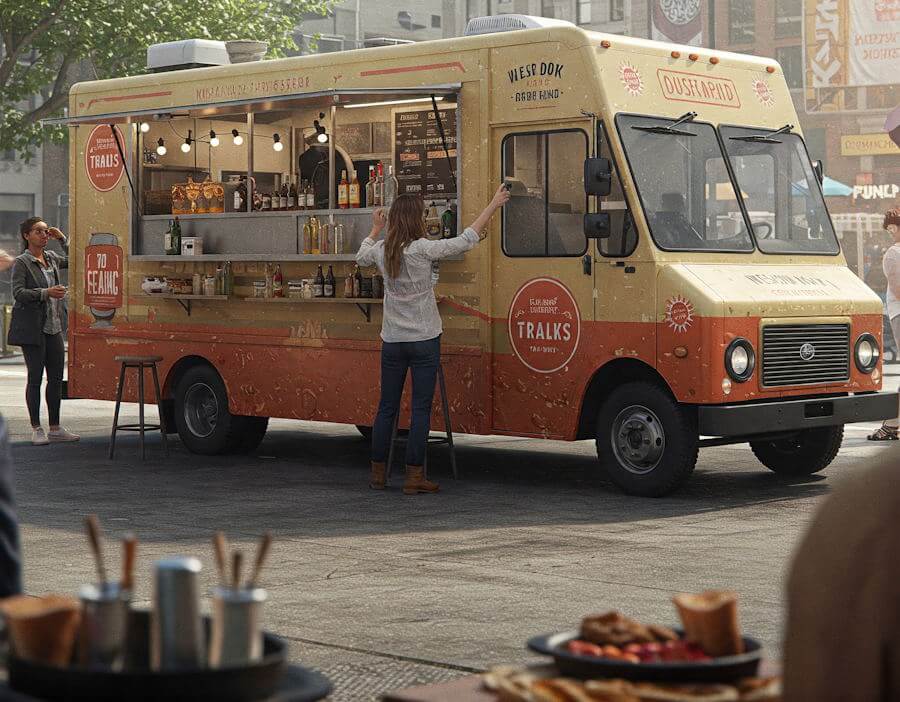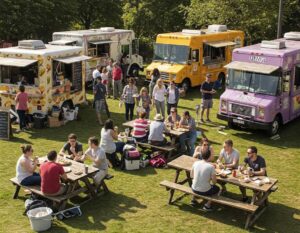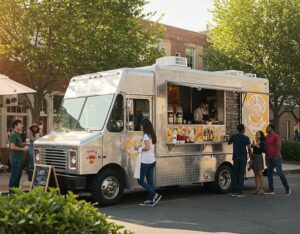Understanding Your Unique Selling Proposition (USP)
In the competitive landscape of food trucks, a well-defined Unique Selling Proposition (USP) is essential. This distinct element sets your food truck apart from the multitude of similar offerings, ensuring that potential customers recognize and remember your brand. The initial step in identifying your USP involves a thorough analysis of what differentiates your food truck from competitors. Consider evaluating aspects such as your menu offerings, the quality of your service, and the overall dining experience you provide.
When assessing your menu, focus on the ingredients, recipes, or culinary techniques that are unique to your brand. For instance, if your food truck specializes in local, organic produce or rare culinary traditions, these features should be prominently highlighted. Additionally, it’s crucial to think about any specific dietary options you may offer, such as vegan or gluten-free alternatives. This can attract specific customer demographics seeking those options.
Furthermore, the quality of service plays a significant role in your USP. Friendly, efficient service can transform a routine food truck visit into a memorable experience, encouraging repeat customers. It’s important to train your staff not only in food preparation but also in customer relations. A dedicated and personable approach can create a welcoming atmosphere that differentiates your food truck from others.
Lastly, consider the overall experience you offer. This encompasses not just the food and service but also the ambiance you create. Whether it’s through vibrant branding, unique truck design, or interactive customer engagement, every element contributes to the impression you leave. Establishing a strong USP will help you forge a loyal customer base, drive brand recognition, and ultimately, enhance your success in the food truck industry.
Crafting a Compelling Brand Story
In the realm of food trucks, a compelling brand story is pivotal in setting oneself apart in a saturated market. Storytelling becomes the backbone of a brand, enriching it with purpose and engaging potential customers on a deeper level. A well-crafted narrative can transform a simple food truck into a brand that evokes emotions, fosters loyalty, and invites curiosity.
The first step in creating an engaging brand story is identifying the core message that encapsulates your journey. This could include the inspiration behind launching the food truck, the unique culinary offerings that set it apart, or even the personal experiences that led to the venture. Articulating your passion and motivation allows customers to see the human element behind the food, fostering a connection that mere facts about the food truck cannot achieve. For instance, was there a family recipe that inspired your menu, or did a memorable travel experience ignite your culinary creativity? Sharing these insights can resonate deeply with your audience.
Next, a food truck’s brand story should reflect its values and personality. Are you focusing on sustainability and local sourcing? Or perhaps you aim to provide exotic flavors and adventurous food experiences? Your brand story should convey these values in an authentic way, helping customers to align their preferences with your offerings. Furthermore, utilizing visuals, such as engaging photography of your food and the truck itself, can reinforce your narrative, making it more relatable and accessible.
Lastly, make sure to engage with your audience through various channels, such as social media, blogs, or customer interactions. By sharing updates and engaging with your community, you maintain your brand story’s relevance and allow customers to be part of your unfolding journey. A captivating brand story not only enhances customer experience but fundamentally establishes your food truck as a memorable entity within their minds.
Designing Eye-Catching Branding Elements
Creating an impactful food truck brand begins with the design of eye-catching branding elements that not only attract potential customers but also convey the essence of the cuisine offered. A well-crafted logo serves as the cornerstone of your branding strategy. It should be distinctive, easily recognizable, and reflect the personality of your food truck. Consider incorporating elements that represent the type of food served or the story behind your culinary journey. A professional graphic designer can help translate these ideas into a visual identity that resonates with your target audience.
In addition to the logo, selecting the right color scheme is crucial for establishing a memorable brand. Colors evoke emotions and can significantly influence customer perceptions. When choosing colors for your food truck, think about the characteristics of the cuisine you serve. For example, vibrant colors can be appealing for fresh and lively dishes, while muted tones may work well for gourmet or fusion concepts. Ensure that the color palette is cohesive across all branding materials, including menus, business cards, and social media profiles. Consistency helps in building brand recognition and trust among customers.
The physical appearance of your food truck, including the wrap design, plays a vital role in attracting attention. A well-designed wrap can transform an ordinary vehicle into a mobile billboard, showcasing your brand and menu offerings to a wide audience. Consider using high-quality materials and professional installation to ensure durability and visual appeal. The design should be clear and uncluttered, featuring your logo, colors, and enticing images of your signature dishes. This allows potential customers to quickly understand what you offer and entices them to stop by for a meal.
Through thoughtful design of branding elements, food trucks can craft a compelling identity that effectively communicates their unique culinary offerings. This cohesive branding attracts attention while building an emotional connection with the audience, ultimately contributing to the truck’s overall success.
Building a Strong Online Presence
In today’s digital age, establishing a robust online presence is crucial for any food truck brand looking to thrive in a competitive marketplace. One of the most effective strategies is leveraging social media platforms such as Instagram, Facebook, and Twitter. These platforms not only enable food truck owners to showcase their culinary creations but also foster a sense of community among customers. By sharing high-quality images of dishes, behind-the-scenes content, and any special promotions, brands can effectively engage their audience and create lasting connections.
Moreover, a functional and visually appealing website serves as the cornerstone of an online footprint. The website should include essential information such as the food truck’s location, hours of operation, menu, and contact details. Incorporating an intuitive navigation system can significantly enhance user experience, ensuring that potential customers find the information they seek with ease. Additionally, a blog section can be a valuable tool for sharing updates, recipes, and informative articles related to the food truck industry. This type of content not only positions the brand as an authority but also encourages repeat visitors, fostering brand loyalty.
Engaging content is another vital aspect of building an online presence for a food truck brand. Brands should consider incorporating polls, contests, and interactive stories on their social media channels to encourage customer participation. By responding promptly to comments and messages, businesses can demonstrate their commitment to customer satisfaction. This two-way interaction not only enhances customer trust but also encourages followers to spread the word about the food truck. Ultimately, a well-executed online strategy, encompassing social media engagement, a well-designed website, and compelling content, plays a significant role in creating a memorable food truck brand.
Maximizing Customer Engagement
Customer engagement is a pivotal aspect of developing a successful food truck brand. Engaging customers both on-site and online fosters a sense of belonging and loyalty that can significantly impact sales and brand reputation. One effective method is establishing a loyalty program that incentivizes repeat business. These programs can operate through digital apps or physical punch cards, allowing customers to earn rewards such as discounts, free meals, or exclusive merchandise after making a certain number of purchases. This approach not only encourages repeat visits but also cultivates a connection between the customer and the food truck, solidifying brand loyalty.
Soliciting feedback is another critical strategy for enhancing customer engagement. Creating avenues for customers to share their opinions—whether through digital surveys, comment cards, or social media interactions—provides invaluable insights into their preferences. Encouraging customers to rate their experiences or to suggest new menu items can make them feel valued and included in the decision-making process. Moreover, promptly responding to feedback, both positive and negative, demonstrates that the brand values its customers’ contributions, further reinforcing their loyalty.
Building a community around the food truck brand is equally important. Hosting events, such as food tastings or community gatherings, can serve to bring fans together and create a memorable experience. Utilizing social media platforms to showcase these events helps cultivate an online following while drawing customers in with engaging content. Sharing stories about the brand’s journey, customer experiences, or behind-the-scenes glimpses can humanize the brand and resonate with customers on a personal level. This sense of community not only aids in customer retention but also encourages word-of-mouth marketing, propelling the brand forward in a competitive marketplace.
Selecting Your Locations Wisely
Choosing the right locations for a food truck is instrumental in establishing a successful and memorable brand. A well-thought-out location strategy can significantly impact daily sales and overall brand visibility. This begins with demographic research, which is essential for identifying potential customers in various areas. Understanding the preferences and habits of these demographics will guide food truck operators in selecting locations that align with their target audience.
Furthermore, locating areas with high foot traffic is crucial for generating sales and increasing brand awareness. Busy streets, popular parks, business districts, and college campuses are exemplary sites where the potential for customer engagement is greatest. These locations not only provide exposure to a larger audience but also create opportunities for spontaneous purchases, enhancing the truck’s profitability. It is beneficial to analyze foot traffic patterns during different times of the day to ensure optimal placement and maximize sales.
Additionally, participating in local events can significantly contribute to brand visibility. Food festivals, farmers’ markets, and community fairs attract crowds looking for unique dining experiences. These gatherings present an excellent opportunity for food truck owners to introduce their offerings to a wider audience. Moreover, engaging with local communities at these events can foster positive relationships and encourage brand loyalty.
In summary, a strategic approach to location selection is vital for building a successful food truck brand. By conducting thorough demographic analysis, identifying high-traffic areas, and attending local events, food truck operators can position themselves for greater visibility and sustained growth in the competitive food truck industry.
Creating Memorable Menu Items
Menu innovation is a crucial element in establishing a memorable food truck brand. The food offerings serve not only as sustenance but as a reflection of the brand’s identity, ethos, and connection to the target market. Crafting unique and delicious food items requires a careful balance of creativity, market research, and brand narrative. One strategy to achieve this is to derive inspiration from the brand’s roots or story. By aligning menu items with the overarching theme or cultural background of the brand, food trucks can create distinct offerings that resonate with consumers.
Incorporating local ingredients can also amplify the brand’s identity. Sourcing seasonal produce or specialty products from local suppliers not only adds freshness and flavor to the dishes but reinforces a commitment to community and sustainability. This approach not only enhances the quality of the menu items but also allows customers to feel more connected to the brand through local sourcing narratives. Highlighting these local elements in marketing communications can further cement the brand’s appeal in the eyes of the consumer.
Another effective strategy for creating memorable menu items is to leverage customer feedback and preferences. Engaging with the target market through social media polls, tastings, or even experimenting with limited-time offerings invites customers into the creative process, making them feel invested in the brand. This participatory approach not only helps refine menu choices but can also lead to the development of signature dishes that become synonymous with the food truck.
Finally, presenting menu items in an appealing manner plays a critical role in memorability. Utilizing digital menus, vibrant visuals, and innovative food plating can enhance the overall eating experience and encourage sharing on social media platforms. By intertwining creativity, local sourcing, and audience engagement, food truck brands can successfully craft memorable menu offerings that capture attention and foster loyalty among consumers.
Leveraging Events and Partnerships
Building a memorable food truck brand is not solely about the culinary offerings; it also involves strategic visibility and community engagement. One of the most effective ways to achieve this is by collaborating with local businesses and participating in food festivals or community events. Such partnerships can significantly boost brand presence and foster customer loyalty.
Collaborating with local businesses can create a mutually beneficial relationship that enhances visibility for both entities. For instance, a food truck can align with a nearby brewery, providing gourmet street food to complement craft beers. This not only attracts diners but also allows the food truck to tap into the brewery’s customer base. Such collaborations can be promoted in both businesses’ marketing materials, thereby widening the audience reach and reinforcing the brand’s identity within the community.
Additionally, participating in local food festivals, farmers’ markets, or community events serves as an opportunity for food trucks to showcase their offerings to a larger audience. These events often draw food enthusiasts who are eager to discover new culinary experiences. By having a presence at these gatherings, food truck brands can engage directly with potential customers, receiving immediate feedback and building rapport. The high foot traffic at such events can foster a positive brand image, as it demonstrates commitment to the local community.
Successful food trucks also leverage these events to create memorable interactions. Inviting local influencers or food bloggers to collaborate can further amplify visibility, as their social media posts can attract attention and drive followers to the food truck. Engaging customers with a unique brand story or themed events can enhance the overall experience, imprinting lasting impressions in customers’ minds.
In summary, local partnerships and community involvement are crucial for food trucks aiming to build a remarkable brand. By actively engaging with the community through events and collaborations, food trucks can solidify their presence and enhance their brand’s appeal.
Evaluating and Evolving Your Brand Strategy
Creating a memorable food truck brand goes beyond just launching with a catchy name and vibrant visuals. It is imperative to engage in continuous assessment and evolution of the brand strategy to remain competitive and relevant in the market. Evaluating your food truck brand’s performance involves regularly measuring customer satisfaction and gathering feedback to gain insights into the customers’ perceptions and experiences. Utilizing surveys, social media polls, and direct interactions can help in understanding what resonates with your audience and what areas require improvement.
In addition to direct feedback, analyzing sales data and customer demographics can illuminate trends in customer preferences and behaviors. This quantitative approach can be facilitated by tools like point-of-sale systems, which not only track sales but also provide valuable reports that can inform the brand’s direction. It is essential to look for patterns that indicate which menu items are most popular, allowing the brand strategy to align with consumer demand. Furthermore, reviewing social media engagements can reveal how well the brand connects with its audience, highlighting strengths and revealing areas that might need fine-tuning.
Adapting the branding strategy based on this collected data is crucial for longevity in the food truck industry. This might involve rebranding certain elements, introducing new menu items, or even tweaking the design of the truck. It is essential to stay flexible and responsive to external factors such as market trends, economic conditions, and evolving customer preferences. Through ongoing evaluation and adaptation, food trucks can not only enhance their visibility and customer loyalty but also ensure their brand remains fresh and appealing in a crowded marketplace.




